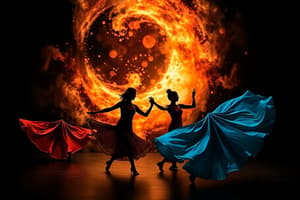Podcast
Questions and Answers
Define rhythm in the context of art and name two performing arts where it is essential.
Define rhythm in the context of art and name two performing arts where it is essential.
Rhythm in art refers to the visual or auditory pattern created by repeated shapes, elements, colors, sounds, and movements. It is essential in music and dance.
What is the difference between formal and informal rhythm?
What is the difference between formal and informal rhythm?
Formal rhythm involves the repetition of a motif in a uniform or regular arrangement, while informal rhythm features variations in form, size, and arrangement.
Explain how repetition contributes to the feeling of movement in a design.
Explain how repetition contributes to the feeling of movement in a design.
Repetition of a movement creates a sense of continuity and flow, which suggests movement within a design.
What role does visual weight play in achieving balance in art?
What role does visual weight play in achieving balance in art?
List two factors that influence visual weight and describe their impact.
List two factors that influence visual weight and describe their impact.
In what ways can rhythm be observed in architecture?
In what ways can rhythm be observed in architecture?
Describe how border design and all-over patterns differ in terms of rhythm.
Describe how border design and all-over patterns differ in terms of rhythm.
How does texture influence the visual weight of an element?
How does texture influence the visual weight of an element?
What is a motif in art, and why is it significant to rhythm?
What is a motif in art, and why is it significant to rhythm?
Identify how contrast can be a factor influencing visual weight.
Identify how contrast can be a factor influencing visual weight.
Flashcards are hidden until you start studying
Study Notes
Rhythm in Art
- Rhythm is a fundamental principle in performing arts, easily perceptible.
- It's found in various art forms, including painting, architecture, music, dance, and poetry.
- Rhythm is created by repeated shapes, elements, colors, sounds, and movements.
- Repetition of a unit or motif creates a visual or auditory pattern, leading to a feeling of movement or rhythm.
- For rhythm to be observed, units should be of similar sizes and distances from each other.
- Formal rhythm is a uniform or regular arrangement of repeating motifs.
- Informal rhythm, on the other hand, involves repeating motifs with variations in form, size, and arrangement.
Balance in Art
- Balance refers to a sense of equilibrium and stability in an artwork.
- It's achieved by balancing the visual weights of lines, forms, values, textures, and colors.
- Visual weight refers to the perceived importance or heaviness of an element within a composition.
- Factors affecting visual weight are size, color, contrast, texture & detail, position, and shape.
Studying That Suits You
Use AI to generate personalized quizzes and flashcards to suit your learning preferences.



